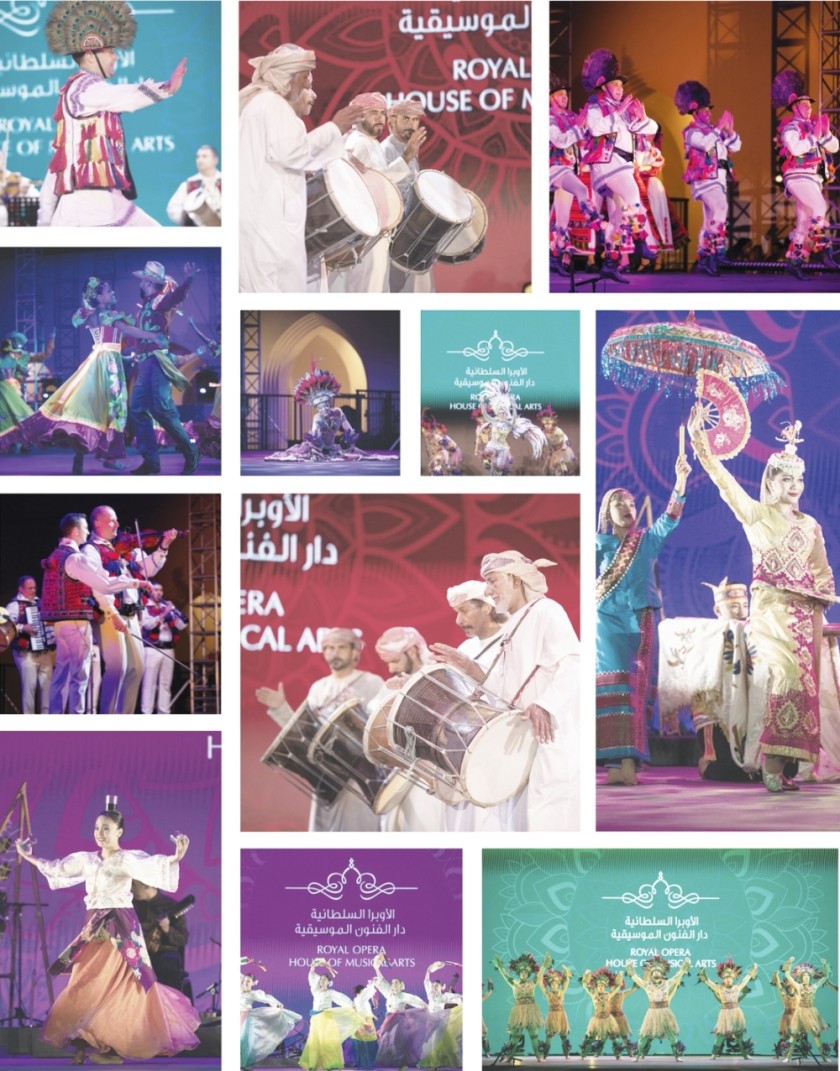

The Muscat weather did not favour Friday’s outdoor Folk Festival in the ROHMA Maidan Al Bahri, so when it was postponed to Saturday evening, the public arrived in droves with bated breath and full of anticipation. The rain held off and the 90-minute show was able to proceed unhindered.
Curiously, all four dance troops in this year’s extravaganza were founded in the late 1950s, but have gone on to develop in style, ability and technique into the present decade.
First up was the “Kamzar Traditional Arts Group” from Khasab which opened with some stunning video footage of the beautiful Musandam scenery including spectacular sea cliffs, the famous fjords, a traditional dhow, and dolphin watching among scattered islands. The 20 male performers entered the arena to a backing track in white dishdashas beating traditional sticks, swords and drums. Their short introductory set concluded with jumping and singing, chanting, and lively call and responses.

They were followed by “The Flor Ribeirinha” group from Cuiabá in Mato Grosso, Brazil. They danced to a contemporary remix recording of indigenous dance music with electronic samba rhythms in perfect synchronisation which barely missed a beat. In “Siriri” (flying ant) their tribal costumes of effective feathered headdresses and leg coverings reflected the ethnic diversity of the state, including African, Portuguese, Spanish and indigenous influences. In “Boi Bumbà” – a ritualised Amazonian Bull Game - a shift to the iconic, colourful swirling dress associated with Brazilian Samba made a fine visual spectacle between fast virtuoso solos and swirling, spinning choruses in a flurry of vivacious colour. As usual, the Brazilian ladies and gentlemen did themselves proud for sheer speed and exuberance.
Most surprising and eye-opening of all perhaps, was the substantial Bayanihan Folk Dance group from the Philippines’ presentation of their dance heritage. They brought five percussionists - no prerecording for them – and each style or region was represented with such exquisite attention to detail, it was hard to believe that this was just one nation’s culture.
Five male dancers with ceremonial swords provided a martial arts display of almost military, gymnastic precision, reflecting Chinese influences while rhythmic beating on the floor with hands in precise timing suggested Japanese Taiko drumming from the 1940s.
Girls appeared with parasols in a demure, stylised movement to a Gamelan-like accompaniment reflecting Malay or Indonesian influences. They danced some intricate, fast footwork between bamboo poles laid parallel on the floor, then were carried off stage triumphant by the boys, as the poles became palanquins for their beloveds. Stringed instruments played as a trio danced with glasses balanced on their heads, Indian-style, but were interrupted by six men in coconut-shell body percussion, comically beating a rhythm upon themselves. Spanish influences were bound to surface, and shoes came off to play percussively upon the floor like castanets, or back on their feet in a passionate Flamenco. The finale was lush and romantic as ladies in hats were swept off their feet by stick-clashing men – with much-needed accuracy!
The Transylvania National Folk Ensemble of Romania provided a powerful last Act to Saturday’s show, bringing their own 12-piece orchestra under conductor, Eduard Albina. The ten men sang and shouted authentic folksong, dancing in traditional black boots and headscarves while ten ladies were dressed in red and white costumes, spinning and dancing to the fast klezmer-style music, featuring clarinet and shawm solos. The Orchestral Suite performed by the virtuoso musicians was captivating, contrasting a romantic ballad with fiddle solos from the Carpathian Mountain regions and bird effects in fast, mesmerising technique from each of the seven violinists.
An Oaş Wedding Ceremony saw the men, Cossack-like, with feathered caps and captivating footwork as they kicked and hit their heels high in the air. All were dressed in embroidered blouses while the girls’ dance movements were more stately and restrained.
“The wild rhythm of the music, as well as the liveliness of the dancers, took the audience back to ancient times of Thracia” and they received resounding applause as the show drew to its close.
The Omani troupe returned with drums and live chants as the Filipino dancers entered the front of the stage to take another Curtain Call. The Brazilians had a plane to catch after their performance, so the vibrant movement of their flamboyant style left no chance to miss that connection with a final bow.
Oman Observer is now on the WhatsApp channel. Click here



